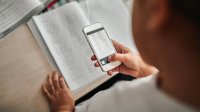How Teachers Can Use Pedagogical Documentation for Reflection and Planning
Students generate a lot of documents that show their thinking, and teachers can use that evidence of learning to improve future lessons.
Your content has been saved!
Go to My Saved Content.The Covid-19 pandemic and working remotely have challenged teachers of all grades to be as creative and innovative as possible, including the way they manage pedagogical documentation. With remote work, teachers often assign asynchronous tasks, which can generate large numbers of documents. Many of these documents, when managed appropriately, can be an extraordinary source of reflection and analysis to improve future curriculum planning.
Whether teaching remotely or in class, choosing what to document and how can seem overwhelming. It also can be daunting to determine which documents to consider for future learning needs. Knowing how to choose what lessons to document and how to document them may reduce the amount of work and at the same time make it more effective.
Here are some ideas for managing pedagogical documentation that have proven to help teachers and pre-K to 12 students work together to choose what is most likely to be useful in curriculum planning for years to come.
Choosing What to Document
Select a learning session that will likely have benefits beyond documenting the work for the current semester and will hold lasting value for future curriculum planning. Then choose the moments in the learning process that you or your students find most relevant. The documents should show the activities that are most likely to generate reflection, analysis, and the development of creative thinking skills and metacognitive skills. These will have the most to offer for future curriculum planning.
Observing and Documenting
The next step is to decide how to make a record of the observation. Choose a technique that will best show the thinking process and learning progression of the students—note taking, photography, audio or video recordings, or a combination of one or more methods.
Families can also provide helpful documentation. For example, the family of a preschool girl recorded her enthusiasm for measuring different objects at home, which led to a follow-up math session. The math teacher used the young student’s passion for measuring as the basis for a class about why people measure things and how to measure using a variety of tools such as blocks, pencils, or hands. One family’s documentation of a student’s love of learning inspired a new math lesson.
The Role of Dialogue
Once you have a suitable sample of documentation, both you and your students may find it helpful to prepare an exhibit about the learning process, carefully choosing the documents that best show the progress of the work.
This can lead to an unstructured conversation in which you ask students about the relevance of the display and ways the display can show the school community how far the students have come. This dialogue encourages the development of critical thinking and provides an opportunity to illustrate the learning process to students and the school community as a whole.
The Purpose of Reflection
This role of pedagogical documentation is different for teachers and students. Teachers reflect to review their teaching method and approach. From the data they collect, they can make decisions about future lessons and the educational evolution of each student.
Students need teachers to help them find the right moment for oral reflection and also to invite them to write or draw their reflections on their learning process. Teachers can ask students questions about what the documentation shows or use a marking criterion so that students can see if they’ve reached their goals. If students haven’t reached their goals, they will be able to see why, as well as what they need to do in order to achieve their goals.
Including the School Community
Teachers should seek feedback from other members of the learning community. When you invite the school community to participate in the learning process, different views and perspectives come into play, which can further support future curriculum planning.
It’s also important to offer the opportunity and provide the resources for families to give feedback. For instance, with the preschool girl who loves to measure everything, the teacher could offer parents and the school community information about the learning process that the young student is using, and provide resources to leave brief feedback about their impressions of the learning process. Then teachers and students can read that feedback and create a new reflection. These are all moments of growth and deep learning.
When using pedagogical documentation in upper grades, the issue is still how much of the documentation is prospective and might shape the design of future learning. For example, if a group of upper-grade students are doing science and environment research on why some communities don’t have running water, it might be relevant to document the experience and the data collected when they visited a water purification plant, and then check what else they need to find out and use that to plan future trips. The documents would then have a prospective objective.
The above example also offers an opportunity for teachers to include math, physics, chemistry, geography, social studies, biology, art, and even performing arts in an interdisciplinary project. Teachers can invite students to explain the purification process through a drama or musical play and assign students tasks in the subjects they need to strengthen. The production can then be performed for the school community.
As long as teachers have the time to work thoughtfully with the documents they’ve collected so that they can adequately reflect and design new paths to learning, and not just view them as documentation of the current semester, pedagogical documentation can help teachers make a meaningful and enduring change in the teaching and learning process.
